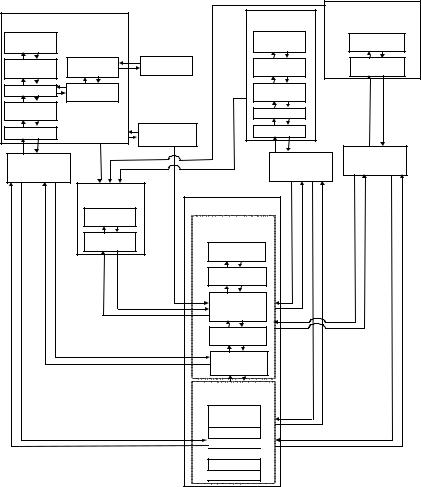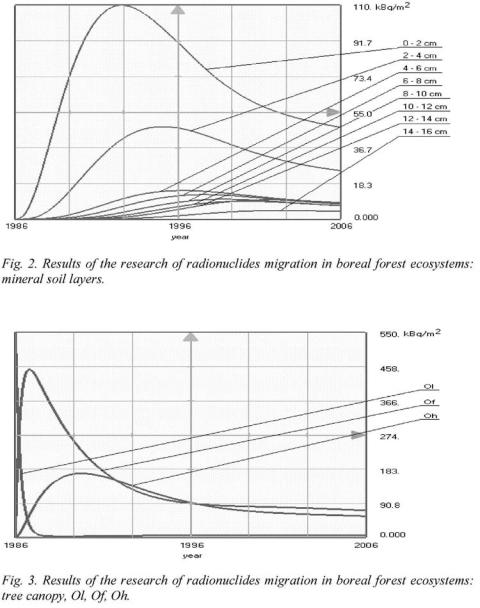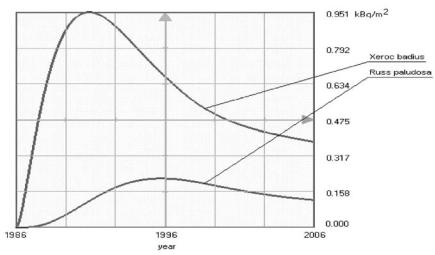
brechignac_f_desmet_g_eds_equidosimetry_ecological_standardi
.pdf284
X O |
x ijO |
|
|
(11) |
|
|
|
|
mυn |
|
|
|
that minimizes the total cost of performance of the special works for the customer (MOD)
m |
n |
|
|
L (X O ) ¦¦cij υ x ijO min L (X ) . |
(12) |
||
i 1 |
j 1 |
{X } |
|
|
|
||
It is an integer task of linear programming at matrix argument of the criterion function [2]. Its solution XO permits to detail the plans of the orders (vectors - columns of the matrix 11) and the plans of performance (vectors - rows of the matrix 11) of the special works by contractors.
The task should be included into the structure of special software of the automated environment management system on military sectors.
References
1.Environmental guidelines for the military sector. A Joint Sweden-United States Project Sponsored by the HATO Committee on the Modern Society. March 1996, 73 pp.
2.Zaichenko Y. P. Operation research. Kiev. Vichsha shkola, 1975, 320 pp (in Russian).
MODELING AND SIMULATION OF 137CS MIGRATION IN BOREAL FOREST ECOSYSTEMS
A. KOVALCHUK, V. LEVITSKY
Zhytomyr Institute of Engineering and Technology, Cherniakhovsky str. 103, Zhytomyr, 10005, UKRAINE
A. ORLOV
Polis’kiy Branch of Ukrainian Scientific Research Institute of Forestry
and Forest Amelioration, Prospekt Myru, 38, Zhytomyr, 10004,
UKRAINE
V. YANCHUK
Zhytomyr Institute of Engineering and Technology, Cherniakhovsky str. 103, Zhytomyr, 10005, UKRAINE
1. Introduction
Modeling of 137Cs in natural ecosystems has a lot of factors that are the basis for mathematical modeling of processes of radionuclides migration in food-chains and for complex analysis of radionuclides migration in natural forest ecosystems [1–3, 6–10, 12, 13, 16 – 18]. Among the variety of models there are some factors for calculation of transfer coefficients for chains soil–plant [1, 10, 18], for assessment of 137Cs content in fruit bodies of fungi or plants [13, 14, 15], for investigation of seasonal variation of 137Cs in game [7, 12], etc. All the types of models mentioned above use different types of analysis and are described by different types of mathematical structures because of analysis of different objects – ecosystem compartments. But all of them use only one or two types of mathematical structure for the process analysis. Such models are useful as we can see they work for a long time giving prediction of processes behavior but they can also be used in another way – the way of multi-step modeling. The main peculiarity of such approach is the multistage process of model forming. Each stage of model creation is connected with a separate process to analyze to using the appropriate existing model.
The approach proposed here includes the following phases:
ξ Determination of tasks of research of ecological processes, which must be solved in the frame of radionuclides migration study.
ξ Formal description of compartments of the forest ecosystem. Description must emphasize exchange processes research and anthropogenic factor definition.
ξ Working towards a conceptual scheme of the ecosystem. The conceptual scheme must take into account tasks selected on the phase1, describe the structure of the ecosystem in terms of “important/negligible”, and define relations between important ecosystem compartments.
ξ Establishing the assumptions concerning balance of radionuclides activity for important ecosystem compartments. The relationships between accumulated
285
F. Brechignac and G. Desmet (eds.), Equidosimetry, 285–292.
© 2005 Springer. Printed in the Netherlands.
286
activities for compartments are defined on the basis of the preformed conceptual scheme.
ξ Calculation of the mathematical model parameters using expert knowledge and relationships between accumulated activities of the ecosystem compartments. Determined parameters allow setting up the model in the form of the system of ordinary differential equations, to analyze the model and to interpret the results.
The following example of the mathematical model of radionuclides migration in boreal forest ecosystems shows some details of the above mentioned modeling approach.
2. Site description and description of conceptual scheme of boreal forest ecosystem
The main type of soil is soddy-podzolic sandy-loam, with an average annual depth of ground water level of about 130 cm. This soil is formed from fluvio-glacial sandy-loam deposits. It belongs to the automorphic group and has an average bulk density of 1,15-1,25 g·cm-3 per10-cm stratum . The main soil mineral is quartz and its content varies from 60 to 85% (in the 0,05-0,01 mm fraction). The clay content is about 0,5%. About 65% of the soil volume consists of particles exceeding 0.01 mm (physical sand). The soil of the analyzed ecosystem is characterized by low natural fertility and unfavorable hydrophysical properties: high water permeability and low water-holding capacity, this causing rapid deep infiltration of melted snow, while considerable quantities of water are evaporated from the upper layers. But this soddy-podzolic soil is favorable to the growth of boreal species – Pinus sylvestris, Vaccinium myrtillus, etc.
Description of soil profile: forest litter thickness reaches 10-15 cm, humus is of a rough moder-type. Forest litter mainly consists of needles of Pinus sylvestris and residuals of mosses (Bryales). The Ah-horizon is grey-black, sandy-loam, its thickness is 8-10 cm , with large amount of roots of dwarf-shrubs, grasses, rhizoids of mosses. E- horizon (eluvium) is light grey, sandy, its thickness varies from 5 to 10 cm, without any roots of plants. Bh-horizon (illuvium) is ferrugineo-brown, loam, dense, with middle diameter roots of Pinus sylvestris. Its thickness varies from 5 to 10 cm. Bi-horizon is yellow-brown, sandy-loam or sandy, exceed to the depth of ground water. It contains separate big roots of Pinus sylvestris.
The dominant tree species is pine (Pinus sylvestris L.) with sparse birch (Betula pubescens Ehrh.). The rising generation includes the same species of trees. The average age of the pine tree is 50 years, birch – 25-30 years. The total amount of pine is 1180 trees, the average height of the pine trees is 22,4 m, diameter – 20 cm. The average density of pine wood biomass is 297,2 metric ton per hectare (in fresh weight).
Vegetation belongs to the floristic association Molinio-Pinetum J.Mat. 1981, Union Dicrano-Pinion Libb. 1933, Ordo Vaccinio-Piceetalia Br.-Bl. 1939 em K.Lund 1967, Class Vaccinio-Piceetea Br.-Bl. 1939. This floristic association is one of the most wide spread in Central Polessye of Ukraine (about 40% of total forested square). Understorey vegetation layer is dense, with total projective cover 70-75%, represented mainly by typical boreal dwarf-shrubs – Vaccinium myrtillus L. (60-65%), Vaccinium vitis-idaea L. (5-10%), Vaccinium uliginosum L. (1-3%) as well as the grasses such as
Molinia caerulea (L.) Mill. (1-3%), Melampyrum pratense L. (1%), Dryopteris

288
In order to create formal descriptions for further modeling the above mentioned ecosystem has been separated into 6 macro blocks. Four of them concern main blocks of vegetation: tree canopy, undergrowth, grass-dwarf-shrubs, mosses; and remaining two: forest litter and mineral soil. The conceptual scheme of described system is given in Fig. 1.
3. Connection between the conceptual scheme of boreal forest ecosystem to formal description and modeling
Formal description of boreal forest ecosystem has been presented as a set of characteristics:
Fji = (Gi, Tj, Spf, I),
where G – is a subset of humidity characteristics G={Gi i =1, 5}; T – is a subset of trophotops T={Tj j =1, 5}; Spf – is a set of species diversity of boreal forest ecosystem; I – is a set of integral characteristics including the biological productivity of ecosystem. Such a description gives a possibility to form subsets of boreal forest ecosystem by means of choice ecosystem type (according to classification of Alexeev-Pogrebnyak). Although relations between ecosystem compartments are not shown on the upper level of the formal description they will be reflected in the formal description of lower levels of formal descriptions. In formal description of boreal forest ecosystem species diversity is presented, as a set of subsets of species is to be involved in analysis. For the boreal ecosystem case the formal description of such diversity is presented as follows:
Spf = {Tr, Ug, Uw, Grb, Fal, Mos, Mush, Lch},
where Tr – is a set of tree species; Ug, Uw – are sets of species of undergrowth; Grb – is a set of grass–dwarf-shrub layer; Fal – fallout dead particles of organic matter from different forest layers; Mos – is a set of moss species, Mush – is a set of fungi, Lch – is a set of lichen.
In order to model a process of radionuclide migration in a boreal forest ecosystem let us consider the ecosystem life cycle from the position of an antropogenic influence on the natural ecosystem. Such a case of anthropogenic influence is concentrated on 137Cs migration in boreal forest ecosystem.
The first period of 137Cs distribution from atmospheric fallout had affected the aboveground phytomass presented in the ecosystem by tree canopy Tr, undergrowth Ug and grass–dwarf-shrub layer Grb. Radionuclides were accumulated in a way of adsorption as well as root uptake.
The formal description of tree canopy taking into account the contamination with radionuclides can be presented as:
Tr = {Wd, Brk, Spr, Ned, Lf, Brch, Rt },
where Wd – wood, Brk – bakr, Spr – annual shoots, Ned – needles (Lf – leaves), Brch – branches, Rt – roots.
Such separation in compartments is important for the investigations of the internal processes of radionuclides redistribution in plants. The layer of grass–dwarf-shrub Grb
289
is presented by the aboveground phytomass and underground phytomass taking into account this layer as a whole disregarding the internal processes of redistribution.
The litter layer is presented in the model by Ol, Of and Oh parts but considering only the process of vertical migration of 137Cs. The layer of lichens is not included into the model but formal description is given to save the openness of the approach for modeling. The layer of fungi has been presented in a model by separate types of fungi because of peculiarities of fungi types.
Mineral soil layers are divided into 10 layers with 2 cm thickness. Soil type is to be characterized by the type of natural forest ecosystem according to classification of Alexeev-Pogrebnyak.
4. Computer-aided set up and simulation for the mathematical model of radionuclides migration in boreal forest ecosystems
The mathematical model of radionuclides migration in boreal forest ecosystems is set up using the approach to the compartment ecosystem models formation [21]. The conceptual scheme of radionuclides migration in boreal forest ecosystems is a start point for working towards a model. Every compartment here adds one equation into the system of ordinary differential equation that is to agree with radionuclides migration processes.
The computer-aided nature of radionuclides migration research is presupposed both for the phase when a user sets up the model and for the phase when a user wants to analyse it. Computer-aided modeling and simulation is provided by a software complex of two components:
1.Information system “Polyn” is to store, edit, replenish and systematize radiomonitoring data, which determine computer-aided parameters matching for the mathematical model.
2.Mathematical software “DSR Open Lab 1.0” is to make an earlier planned approach for the simulation runs. It performs the eventual simulation runs for the preformed mathematical model of radionuclides migration in boreal forest ecosystems using such parameters as the input to be used, the period to be simulated, the quality of the results to be expected, etc.
Besides the usual profits of a computer-aided research process, a user can transfer easily the considered approach for the radionuclides migration in boreal forest ecosystems to an arbitrary number of other forest ecosystems due to the integration of the information monitoring data management system and the mathematical software.
A prognosis of radionuclides migration in mineral soil layers is presented on Fig. 2. Here we can see a clear trend toward considerable accumulation of the radioactivity value in the mineral soil layers at a depth of 0-2 and 2-4 centimetres. It can be explained by means of the litter behaviour for the boreal forest ecosystem. This thick layer stands as a permanent source of contamination for underlying layers.
The next figure (Fig. 3) allows to concluding that pine-tree is able to accumulate and retain big radioactivity value for a long time while taking up minerals from the great bulk of underlying layers. Ol contains a small amount of radioactivity due to the its periodical renewal with litter-fall that is characterized by a minor content of 137Cs as far as the radiation disaster becomes a thing of the past.

290
Trends of accumulation of the radioactivity value for Xerocomus badius and Russula paludosa is shown on Fig. 4. This graph allows to conclude that the dynamics of 137Cs specific activity for Xerocomus badius and Russula paludosa lies in constant growth up to years of 1996-2004 and in lessening of this value during the following period.

291
Fig. 4. Results of the research of radionuclides migration in boreal forest ecosystems: Xerocomus badius, Russula paludosa.
6. Conclusion
The software complex, considered in this work, sets up the mathematical model of radionuclides migration using formal description of the forest ecosystem. The proposed approach to the modelling process allows to automate research of radionuclides migration in the boreal forests and to transfer easily the modelling procedure to other forest ecosystems. The phase of setting up the model is reduced for a user to the defining of relations between compartments of the ecosystem. Conversion of mathematical language constructs into domain-specific ones thus and so brings modelling closer to the ecologists.
Trends of radioactivity in the compartments, taken from simulation runs of the mathematical model of radionuclides migration in the boreal ecosystems, are corresponding to the radiomonitoring data and are able to provide prognosis for radionuclides redistribution in the ecosystem. Effective management of forest resources can be reached by means of interpreting the results of the model analysis.
7. References
1.L.G. Appleby, L. Dovell, Yu.Ê. Mishra The ways of radionuclide migration in environment. Radioecology after Chernobyl Catastrophe. – Ì.: Ìyr, 1999. – 512 p. (in Russian)
2.À.Ì. Dvornik, Ò.À. Zhuchenko The 137Cs behavior in pine forests of Belorus Polissya: modeling and prediction // ÀNRI, The Journal of Radiation Ecology. – 1995. ¹ 3/4. – Pp. 56–66. (in Russian)
3.B.P. Ivchenko, L.À. Martyschenko The Information Ecology. Part 1. The risk assessment from technogenous accidents and catastrophes. The statistical interpretation of ecological monitoring. The modelling and prediction of ecological situations. – St.-Ptb.: “NorMed-Publ”, 1998. – 208 p. (in Russian)
4.Ì.Ì. Kolodnytsky The typology of mathematical models of technical systems. Part 2 // Visnyk ZhITI.–
292
1998. – ¹ 7/Technical Sciences. – Pp. 208–218. (in Ukrainian)
5.Ì.Ì. Kolodnytsky, V.Ì. Yanchuk “Polyn” – the information system for assessment of radiation contamination of Zhitomir region after Chernobyl catastrophe // Visnyk ZhITI. – 1998. – ¹ 9/Technical Sciences. – Pp. 271–278. (in Ukrainian)
6.Ì.Ì. Kolodnytsky, V.Ì. Yanchuk Systems analysis of problems of mathematical modeling in environmental sciences. (in Ukrainian)
7.V.P. Krasnov, Z.Ì. Shelest, Î.Î. Orlov, Ì.Ì. Kaletnyk, S.P. Irklienko, V.Ì. Turko Padioecology of Roe Deer in Central Polissya of Ukraine. – Zhitomir: Publishing “Volyn”, 1998. – 128 p. (in Ukrainian)
8.S.V. Mamikhin, L.N. Merkulova The computer investigations of dynamics of radionuclides in forest ecosystems contaminated in a consequences of Chernobyl accident (1986–1995) // The radiation biology. Radioecology. – 1996. – V. 36, ¹. 4. – Pp. 516–523. (in Russian)
9.Yu.Ì. Svirzhev About the mathematical models of biological communities and tasks of optimization and control connected with them // The mathematical modeling in biology. – Ì., 1975. – Pp. 30–53. (in Russian)
10.S.V. Chernyshenko About the mathematical modeling of biogeocenosis dynamical structure // Environmental sciences and noospherology. – 1997. – Vol. 3. – ¹ 1–2. – Pp. 65–86. (in Russian)
11.V. Yanchuk Problems of computer assessment of Chernobyl catastrophe on people illness // Visnyk ZhITI. – 1998. – ¹ 8/Technical Sciences. – P. 271–276. (in Ukrainian)
12.R. Avila Radiocesium transfer to roe deer and moose. Modeling and experimental studies. Doctor’s dissertation. – Uppsala. – 1998. – 121 p.
13.Chernobyl Digest 95–98 /Interdisciplinary Bulletin of the Chernobyl Problem information. Issue 5. – Minsk, 1999. – 257 p.
14.V.P. Krasnov, Z.Ì. Shelest, Ò.V. Êurbet 137Cs contamination of mushrooms in the Ukrainian Polessye // Abstr. Of III Congress on Radiation Research “Radiobiology, Radioecology, Radiation Safety” (Moscow, 14–17 October 1997). – Pushchino, 1997.–Vol. 2. – P. 353–354.
15.Ò.V. Kurbet The regularities of 137Cs accumulation by edible mushrooms in forests of the Central Polessye of the Ukraine // Abstr. ² Internat. Conf. “Ecology and youth”. – Gomel, 1998. – Vol. 1, Part. 2.
– P. 106.
16.I. Linkov, W.R. Schell (eds.) Contaminated forests. Recent Developments in Risk Identification and Future Perspectives. Kluwer Academic Publushers, 1999. – PP. 151–160
17.I.G. Malkina-Pykh. Modeling of the dynamics in Sr-90 content in ecosystems of various geographical zones // Radiatsionnaya biologia. Radioekologia. – 1996. – V. 36, ¹ 1. – P. 112–132.
18.A.A. Orlov Regularities of technogenous radionuclide accumulation and migration in forest biogeocenosis of boreal coniferous type: research progress 1996–1999 // Chernobyl Digest 95–98 / Interdisciplinary Bulletin of the Chernobyl Problem information. Issue 5. – Minsk, 1999. – PP. 18–31.
